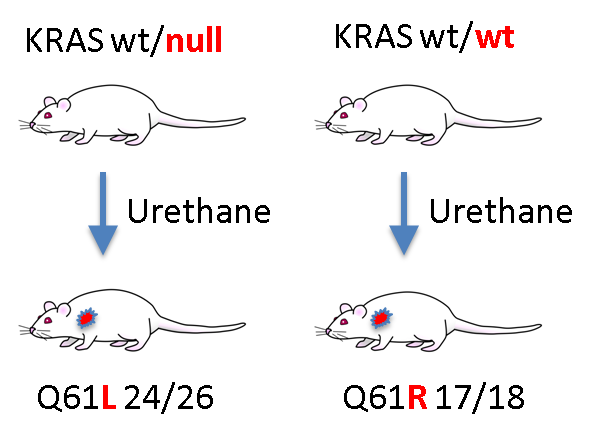More Evidence That a Wild-Type KRAS Allele Plays a Role in Cancer
, by Jim Hartley
Results in a recent paper ("The mutational landscapes of genetic and chemical models of Kras-driven lung cancer” Nature 517, 489–492, 22 January 2015) are highly intriguing. Balmain and colleagues use deep sequencing and existing mouse models of lung cancer to support three themes. The lung cancers were induced either by allowing random expression of an oncogenic mutant (G12D) of KRAS using a genetic model (KRASLA2), or by treating the mice with carcinogens (methylnitrosourea [MNU] or urethane). MNU induces the same KRASG12D mutation as seen in the genetic model, enabling a direct comparison of tumors initiated by the same mutation but by different methods.
First, exome analysis showed that tumors appearing in KRASLA2 mice were characterized predominantly by gene copy number changes, and relatively few missense mutations. Tumors caused by carcinogens had the inverse spectrum, with few copy number changes but many mutations. (This is presumably independent of the KRAS allele but dependent on MNU, which is a DNA methylating agent known to cause G>A transition mutations. This is exactly the mutation found in Kras itself, and the predominant mutation genome-wide in tumors initiated by this carcinogen.) The authors observe that their observations are consistent with a recent analysis of TCGA data (Ciriello, G. et al, Nature Genet. 45, 1127–1133, 2013), demonstrating two major categories of human cancers characterized either by frequent point mutations or by frequent gene copy number changes.
Second, they show data supporting the idea that a wild-type allele of KRAS plays a tumor suppressing role. Mice with one wt allele and one null allele (these mice carried an LSL G12D allele that was silent because Cre recombinase was not induced) developed "more and larger" tumors after carcinogen treatment compared to mice with two wt alleles.
Third, Balmain and colleagues show data that suggest different biologies for different KRAS Q61 mutants. When treated with urethane, mice with two wt KRAS alleles developed almost exclusively Q61R mutations (17/18), while mice with one wt KRAS allele and one null allele developed almost exclusively Q61L mutations (24/26). The data suggest that levels of signaling through the wild-type KRAS affect mutation selection at the initiation stage. Does anyone have ideas on what experiments would illuminate these surprising results?
About the Author
In a previous life Jim Hartley worked in biotech and helped develop Gateway cloning. At the Frederick National Laboratory for Cancer Research he manages the scientific content of Cancer.Gov/RAS.
